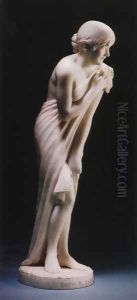Cesare Lapini Paintings
Cesare Lapini was an Italian sculptor born in 1848, in Florence, Italy, a city known for its rich artistic heritage. Lapini's work is often associated with the Neo-Classical style, characterized by its return to the classical ideals of beauty, harmony, and proportion found in ancient Greek and Roman art. He was particularly noted for his skill in marble sculpture, contributing to the 19th-century revival of classical themes and techniques in Italian art.
Lapini trained in Florence, a city that was at the heart of the Italian Renaissance and remained a vital center for art and culture into the 19th century. His education and early career were influenced by the artistic environment of Florence, where he was exposed to a blend of Renaissance masterpieces and contemporary artistic movements. He developed a particular interest in sculpting the human form, with an emphasis on capturing emotional expression and intricate detail.
Throughout his career, Cesare Lapini participated in various exhibitions, gaining recognition and acclaim for his work. His sculptures often depicted mythological and allegorical figures, imbued with a sense of idealism and beauty characteristic of Neo-Classical art. Lapini's ability to convey delicate emotions and his meticulous attention to detail in the rendering of figures and drapery won him admirers in Italy and beyond.
Despite his success, Cesare Lapini remained closely tied to Florence, where he contributed to the local artistic community and influenced the next generation of sculptors. His works can still be found in museums and collections in Italy and around the world, serving as a testament to his skill and artistic vision.
Cesare Lapini passed away in 1893, leaving behind a legacy of work that reflects the enduring appeal of classical beauty and the high level of craftsmanship associated with Italian sculpture of the late 19th century. His contributions to the Neo-Classical movement have ensured his place in the history of Italian art, remembered for his dedication to the ideals of classical antiquity and his ability to bring those ideals to life through his exquisite marble sculptures.


